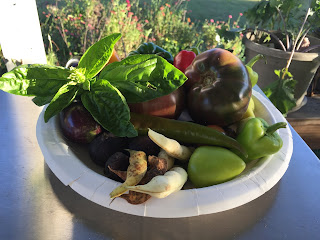 |
| Fall savoy cabbage |
A rule of thumb is that if you eat the tuber, leaf or flower, it is typically a cold season crop. If you eat the fruit or seed, it is a warm season crop.
Choose the Right Varieties
 |
| Fall savoy cabbage |
 |
| Harvest from September garden |
A quick reminder, save the seeds from your best performers to plant next year! You can replant seeds from any heirlooms or open pollinated plants and they will be like their parent; hybrids likely will not. Not only does it save you money, but it also gives you the plants that do the best under your garden and zone conditions. Be sure to save seed only from disease free plants. Seed saving-fun, easy and a cost saver
 |
| Garden in the morning |
 |
| Spaghetti squash sitting on hummingbird vine |
 |
| Red zinnia |
For more on how to choose varieties to grow, starting seeds and transplanting, see this post. Time to plant for fall and winter harvests! You're targeting for your edibles to be full size by early November before daylight hours dwindle to less than 10. The winter slow down
Look at the germination temperatures of the cool season crops you are starting from seed as some will not germinate well in the hot summer temperatures and you may have better luck starting them in shade or indoors. Lettuce is one that germinates best at temperatures below 70F. I like to start my seeds in pots in the shade on our north covered patio. It gets morning sun but is shaded all afternoon. Being on the patio lets me keep a close eye on them, too. After they sprout and are a good size, I move into their permanent spot.
Here is a by month schedule of what to plant for fall and winter harvests in a Midwest garden.
June
Seeds-Parsnips, potatoes
July
Seeds-Beets, carrots, Asian greens (pak choi, tat-soi), cilantro, collard greens, endive, escarole, frisee, fennel, green beans, kale, kohlrabi, leeks, mustard, onions, parsnips, rutabaga, scallions, lettuce, sweet corn, turnips, turnip greens, and Swiss chard.
Transplants-broccoli, Brussel sprouts, cabbage, cauliflower, Chinese cabbage, Bibb lettuce.
August
Seeds-Beets, carrots, greens (arugula, Chinese cabbage, collard greens, corn salad, kale, lettuce, miner’s lettuce, spinach, mustard, endive, turnip greens), fava beans, green beans, herbs, kohlrabi, onions, snap peas, scallions, snow peas, rutabaga, winter and summer radishes, and turnips. Early August is last chance for cucumbers, squash, and corn.
Transplants-Asian greens, broccoli, cabbage, cauliflower, Chinese cabbage, endive, kale, lettuce.
September
Seeds-hardy lettuce and greens, kale, collards, turnips, radishes, kohlrabi, spinach, Asian greens, scallions, carrots, and winter radishes. Quick maturing peas, favas, and bush beans at beginning of the month.
Transplants-hardy lettuces, spinach, collards, broccoli, all perennials, trees, shrubs, greens, spinach
Seeds-more spinach, kale, traditional southern and Asian greens, carrots, winter radishes, beets, short day onions if overwintering, peas, perennial onions, garlic and shallots. In our Zone 7 garden, garlic and shallots can be planted into November. Order your favorite garlic early as many sell out quick. Time to plant garlic! With growing tips......
If you don’t want to start seeds, have waited too long for seed starting or just want to see what varieties do well in your area, some big box stores and local nurseries will have fall planting veggies. If none in your area do, there are many mail order seed companies that carry fall bedding plants.
Late August, early September is the best time to get transplants into the garden for fall and winter harvests. Don't forget to fertilize when planting like you would in the spring. Keep your transplants watered for them to get established until the fall rains start.
Extend the harvest by covering when the first frosts and freezes come to those crops that don’t overwinter without cover. I grow all my greens and lettuce in pots that I cover around Thanksgiving when it gets consistently down in the 20’s. I’ll still have lettuce and greens growing in the spring.
 |
| "Well used" self watering pot I started my lettuce seeds in |